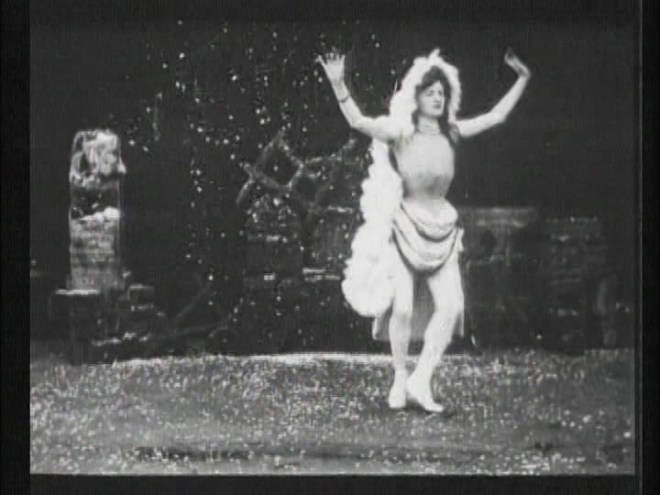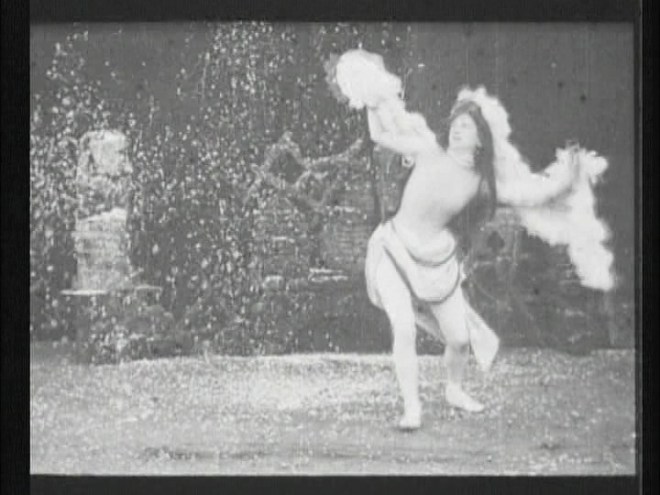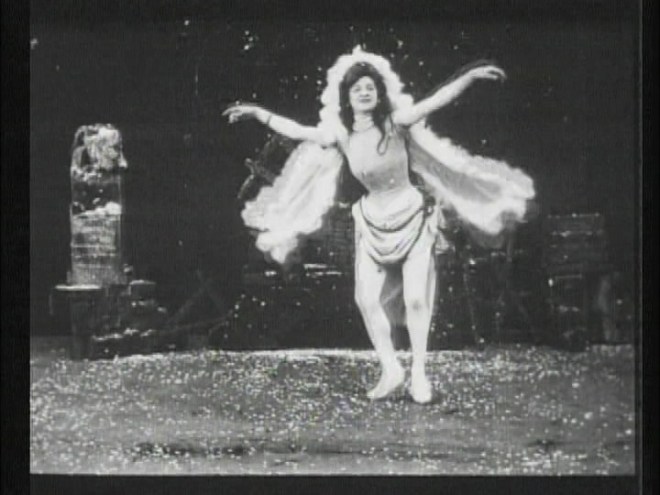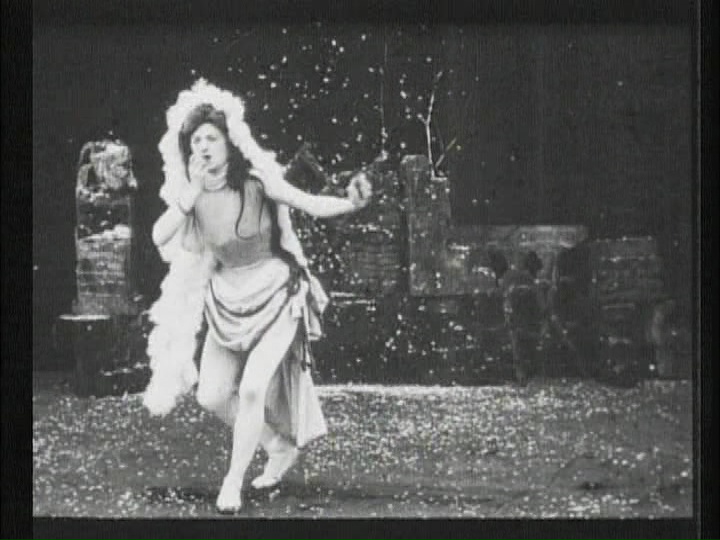A short dance film from pioneering director Alice Guy. A young woman dances through feathery snowflakes in what was once on fourth of a four-part dance of the seasons.
This is my contribution to the Winter in July Blogathon hosted by Moon in Gemini. Be sure to read the other chilly posts!
Brrrr!
In 1900, Alice Guy was continuing as a pioneering talent in the still-new motion picture industry. She is often listed as one of the first women directors but the fact is, she was one of the first directors of any kind with her first confirmed work from the very earliest days of art.
Guy was already something of a veteran—well, as much of a veteran as any industry in its first decade can claim—when she directed this little dance picture. Dance films had been popular since the days of peepshow movies and they continued to be a draw when the movies began to be projected on a screen.

An unnamed dancer twirls about in artificial snow in order to personify the winter season. That’s pretty much all there is to it, though I do think the young lady would probably have been warmer if she had put some pants on.
I absolutely love these dance films as they use one art, the movies, to preserve another that would have otherwise been lost. This film is also interesting because what appears to be a copyright card slides into the frame mid-dance and then slides back again. During this period in film history, copyright issues had not been ironed out in the courts and outright film theft was common. The most popular method of claiming ownership seems to have been incorporating the company logo into the background somehow but some French films also employed colored title cards to discourage pirates. “Genuine if the titles are red!” That sort of thing. Guy’s method is interesting but I can see why the other techniques would have been more practical.

This film was originally accompanied by dances for Spring, Summer and Autumn as well. Spring featured roses, Summer had grapes and Autumn had a general harvest. These films seem to be missing and presumed lost so we are very fortunate that winter survived for us to enjoy.
Guy was on solid historical, artistic and crowdpleasing ground with this picture. Dance films were remarkably popular during the early days of the film industry. First, they captured movement and showcased the power of cinema. Second, they allowed everyone to enjoy the performances of famous dance stars they would never have a chance to see in person. Third, they allowed filmmakers to employ hand-color as the flowing movements of the dancers and their skirts, scarves and accessories meant that colorists didn’t have to worry quite so much about staying in the lines, so to speak.

I do not know whether or not Winter, Snow Dance was originally hand-colored but I think it highly likely that it was, especially when released together with Spring, Summer and Autumn. These films would have made an attractive color package and could likely have been sold worldwide for a handsome sum. (Colored films commanded a higher price than black and white and the French were the masters of the art.)
The concept of dancing to represent the seasons is likely as old as the very concept of seasons and dances tied to climate, weather and celestial phenomena can be found in every culture. To bring things into a more specific Western European context, Antonio Vivaldi’s Four Seasons is probably the most famous seasonal piece in the classical repertoire but Schubert, Mahler, Delius, Haydn and others all brought the concept of the seasons into their work. Going further back, medieval German poet Neidhart von Reuenthal worked in the extremes of summer and winter to create an impressively funny and sarcastic body of work. His music in turn inspired the Niedhart Fresken, some of the earliest secular frescoes of their kind, which portray the four seasons. Before we go further down the research rabbit hole, let’s just all agree that seasonal art has a long and proud tradition.

It is doubtful that Guy planned any deep meaning with her film, she was out to create a work of entertainment and tapped into something that was deeply embedded in the artistic and cultural DNA of her world. This is not meant to be dismissive, merely an observation that trying to spackle some kind of deep meaning onto something that was always intended as light entertainment can have a crushing effect. Guy knew how to construct a popular film before many people had even seen a film and that is impressive in itself.
This is a fun little picture that is purely of its time and is all the more charming for it. Highly enjoyable.
Where can I see it?
Included in the Gaumont Treasures box set along with numerous other films from Guy, Louis Feuillade and Leone Perret.
***
Like what you’re reading? Please consider sponsoring me on Patreon. All patrons will get early previews of upcoming features, exclusive polls and other goodies.

Capturing lovely moments – what could be more important? Thank you for introducing me to the Winter Dance.
Thanks for stopping by! I do love a good bit of century old dance!
I’d bet a penny that fake snow ate into the pants budget. 😀 As usual, you make the silents more educational!
Yes, better planning was clearly called for 😉
Just watched this on YouTube, and it is lovely.
Also, I liked what you said about Alice Guy being one of the first directors in the industry, so I’ve resolved to stop saying “one of the first Female directors”. No such qualifier is needed.
Furthermore, I’m greatly distracted by the great swag you’re offering! I’m off to take a better look…
Yay! Thanks so much!
I re-watched this Alice Guy little jewel just now, and cannot say enough good things about Gaumont Treasures. Great value for money in this wonderful set of discs.
And, a big “Thank You!” for directing us to the Winter in July Blogathon which we’d missed in all the hubbub of summer!
My pleasure! 😀
What a lovely little film! One of the things I like about early silent films is they are almost like time capsules. Perhaps the pantsless dancer was a thing back then?
Thanks so much for bringing this to the blogathon!
Thanks so much for hosting. It’s not a French silent without a little oo-la-la. 😉